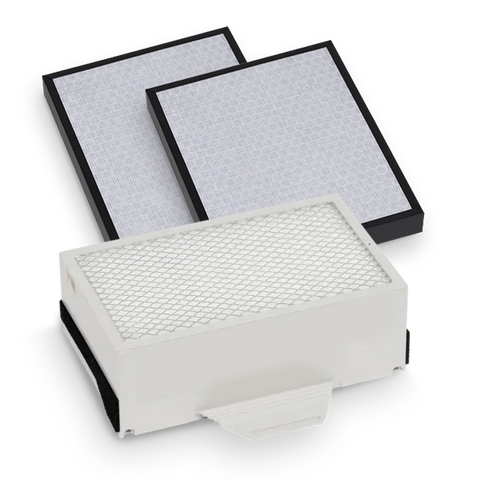In your search for better indoor air quality you have probably come across air purifiers and dehumidifiers. Both can have positive effects on your indoor comfort level, but they are very different machines. Let’s take a look at both air purifier and dehumidifier basics so you can see how you can benefit from both.
Understanding Air Purifiers
An air purifier is something that removes pollutants from the air. The pollutants can be tiny particles or chemicals (or both) depending on the type of air purifier. Most homes and businesses with a HVAC system have some sort of air filter. This filter is mostly designed to protect the HVAC system, not clean the air. An air purifier is a dedicated air cleaning tool with a single purpose: improve indoor air quality.
Air Purifier Types
There are several different kinds of air purifiers on the market:
Mechanical - Mechanical air purifiers use a mesh filter made of thin fibers (paper, plastic, or fiberglass) in multiple layers to create a screen that traps particles. This fiber-like filter media captures particles through inertia, interception, impaction, or electrostatic attraction. HEPA filters are a type of mechanical filter, and most portable air purifiers fall into this category. They are great for capturing allergens like pet hair, pollen, dust mites, and other airborne irritants.
Adsorption - Adsorption air purifiers primarily use activated carbon air filters to eliminate chemicals, odors, and volatile organic compounds (VOCs) from the air. It's important to differentiate adsorption from absorption; adsorption happens on the surface, while absorption penetrates the material. These purifiers leverage the large surface area of materials like activated charcoal to capture airborne chemicals.
Ultra-Violet (UV) Light - UV-C light air purifiers utilize short-wave ultraviolet (UV-C) light (generated by a bulb or LED source) to deactivate microorganisms. This UV light damages the DNA/RNA of microorganisms, preventing their reproduction. Shielding is essential to avoid accidental exposure to living creatures. These purifiers do not physically remove particles from the air, and the UV light source requires periodic replacement due to declining effectiveness over time.
Ion Emitting - Ion emitting electronic air cleaners generate negative ions using a high-voltage electrical field. These ions charge airborne particles, which are then attracted to surfaces like filters. Some versions use electrostatic precipitators to charge particles and attract them to oppositely charged collecting plates, which require periodic cleaning. However, these air purifiers often emit ozone, a harmful air pollutant.
Ozone Emitting - Ozone can purify air by eliminating microorganisms and odors, but it requires careful handling. While effective, ozone is harmful to living organisms and can generate other harmful byproducts. Because of the potential harmful side effects, ozone air purifiers are generally reserved for specialized applications.
In addition to using an air purifier there are a few other ways you can help improve your indoor air quality:
- Vacuum often (ideally using a HEPA equipped vacuum filter)
- Wipe downs surfaces often to remove dust
- Use a humidifier/dehumidifier to maintain an ideal humidity level between 30-60%
- Wash pet bedding often to remove pet dander
- Leave shoes at the door to prevent tracking particles inside the house
- Keep doors and windows shut on day when outdoor air quality is poor
Making healthy air habits part of your normal routine can help reduce asthma symptoms, relieve nasal irritation, and protect respiratory health.

Understanding Dehumidifiers
Maintaining an ideal indoor humidity level helps immensely with indoor air quality (IAQ) and comfort. Removing excess humidity from the air is the job for a dehumidifier.
Why Humidity Level Matters
Air that is too dry or too wet can have negative effects on your health and your home. Experts recommend keeping indoor humidity levels between 30% and 60%. Dry air is a form of easy mold prevention since mold cannot grow. Since mold spores are on the list of airborne irritants, using a dehumidifier is a great way to help improve IAQ. Dry air also feels cooler as it allows sweat to evaporate from skin easier, making it possible to use the A/C less in the summer.
Dehumidifier Basics
If you’ve ever watched water collect under your glass of ice water on a cold day, then you’ve seen the basics of how a dehumidifier works. In fact a dehumidifier has more in common with your refrigerator or air conditioner than your air purifier.
First humid air is drawn into the dehumidifier using a fan. Next the air passes through a cooled coil. The cooled coil is chilled using compressed refrigerant supplied by the compressor. The humid air passes through the cooled coil and collects on the coil surface. The collected water then drips into a collection tank or into a pan connected to a condensate line connected to a drain. The less humid air then passes through a heating coil which further dries the air. The now dry and warm air then exits the dehumidifier.
Dehumidifiers are available in several designs:
- Portable dehumidifier - These units are compact and designed to be moved around to where they are needed.
- Tankless wall-mounted dehumidifier - These units are mounted to the wall or ceiling. The collected water is discharged via a condensate line to an existing home drain pipe.
- HVAC integrated dehumidifier - These units are added to the existing HVAC system. They use the HVAC fan to move air through the unit.
Dehumidifier Features
Portable dehumidifiers usually have a built-in water collection tank, but some can be connected directly to a water drain for nearly maintenance-free use. Most dehumidifiers use a humidistat to control operation of the unit, switching on when humidity levels are too high, then switching off when the desired humidity level is reached. Many units have a built-in digital hygrometer which can display the current relative humidity. If you are looking at a dehumidifier that features bi-polar ionization, make sure it is UL 2998 certified for zero ozone emissions.
Dehumidifiers require electricity to operate, which is why it is suggested to look for units with the Energy Star® certification. The certification states that the dehumidifiers are an energy efficient design to help lower the cost of operation.
Improving Indoor Air Quality
Maintaining good indoor air quality is imperative for your health and well-being.
High Humidity Is The Problem
High humidity levels can have negative health effects over time. One health issue is mold growth (including black mold) which can occur in areas of high humidity. Mold growth means mold spores, which can trigger allergies and asthma attacks. Dust mites especially like warm, humid air so they can multiply. Higher humidity levels can also affect the creation of chemical pollutants in the air.
Keeping Moisture At Bay
Using a dehumidifier is the best form of indoor moisture control. Ventilation works well when the outdoor air quality is favorable, but that isn’t always an option. A dehumidifier can be set to maintain a specific maximum humidity point. It is also important to keep uncontrolled water sources from adding to indoor humidity levels. Repair any leaking pipes, roof leaks, or foundation seepage promptly before mold growth or water damage can occur.
Working Together
Using a dehumidifier along with an air purifier is the best way to remove air pollutants and excess moisture. The air purifier removes airborne contaminants while the dehumidifier maintains an optimal humidity level. Humidity levels have been linked to respiratory infections, typically caused by allergens and pathogens. Both controlling humidity levels and removing viruses, bacteria and allergens helps deliver a two-prong approach for healthier indoor air quality.
Tackling Allergies
When it comes to fighting against allergies, both the air purifier and dehumidifier have their benefits. Both units can improve indoor air quality, but do so in different ways.
Removing Allergens
If you want to remove allergens from the air, you need an air purifier. Things like pet hair, pollen, mold spores, dust, and other unhealthy air particles can kick off an allergy attack. By removing these particles from the air, the likelihood of an allergy attack or allergy symptoms is reduced. Air purifier use has been shown to benefit those who suffer from allergies.
An air purifier that is equipped with an activated charcoal filter can also remove harmful chemicals and VOCs. These harmful airborne chemicals can cause respiratory irritation and make allergy symptoms worse.
Preventing Allergens
In most cases excessive humidity is the root cause of allergens. Mold and mildew grow best in damp areas with humidity above 70%. Once mold spores find a cozy, damp place to grow it isn’t long before an entire mold colony is established. The mold colony creates mold spores, continuing the cycle. A dehumidifier won’t remove mold, but it can keep it from spreading.
Dust mites are another allergen source that prefer humid air. Dust mites like carpets, bedding, or any other place that gives them access to lots of skin cells to eat. But it isn’t the dust mites themselves that cause allergies, but their waste. By keeping the humidity down near 50% you can help control dust mites. Some people are allergic to certain insects and their body parts (cockroaches for example). By keeping the humidity level low it is harder for insects to survive indoors.
A dehumidifier can’t physically remove allergens like an air purifier, but can be quite effective in preventing allergens from appearing in the first place.

Choosing Between An Air Purifier Or Dehumidifier
Before you decide whether you are shopping for air purifiers or humidifiers, you need to ask yourself what you are trying to improve:
If these are your goals, you need an air purifier:
- Eliminate airborne chemicals, particulates & pollutants
- Eliminate airborne allergens
- Have fewer allergic reactions
- Eliminate smells
- Eliminate pollution that seeps in from outside the home
- Better indoor air quality
If these are your goals, you need a dehumidifier:
- Reduce indoor humidity levels
- Be more comfortable in summer months
- Minimize dust mites
- Reduce mold growth
Both an air purifier or a dehumidifier can help with these health needs:
- Help reduce allergy symptoms
- Reduce respiratory illnesses
Maintaining Ideal Relative Humidity
One of the main device differences is moisture control. An air purifier will not change your indoor humidity level. For those who live in a humid climate or live in an area that experiences higher humidity levels for a portion of the year, it can be difficult to maintain an ideal indoor humidity level. You may have a unique situation that leads to high levels of moisture in the air duo to house design or local geography. That is why a dehumidifier is an important asset in creating the ideal balance of moisture in the air.
Clearing The Air
There are certain situations where an air purifier is the exact tool you need to clean indoor air. Keeping wildfire smoke and soot from taking over your house is the ideal use case for an air purifier. The same for anyone living in an area that is known for high pollution levels. The Intellupure Compact removes up to 99.97% of allergens, mold, and viruses. It also has a 6-stage pre-filter that removes harmful chemicals, odors, and volatile organic compounds (VOCs).
Choosing Between The Two
If the humidity level inside your house is too high, you need a dehumidifier. Ideally you should be using both an air purifier and a dehumidifier together. Cleaner air that is also the right humidity level means better comfort and health. Cleaner air also makes it easier for the dehumidifier to work since it won’t get clogged up with dust and debris.








